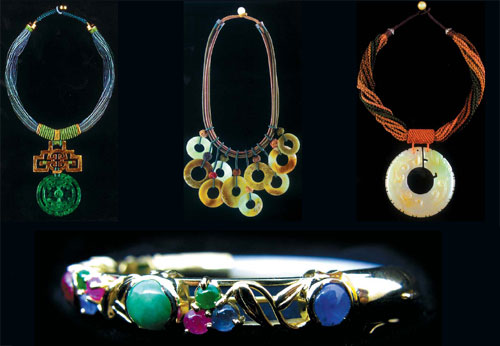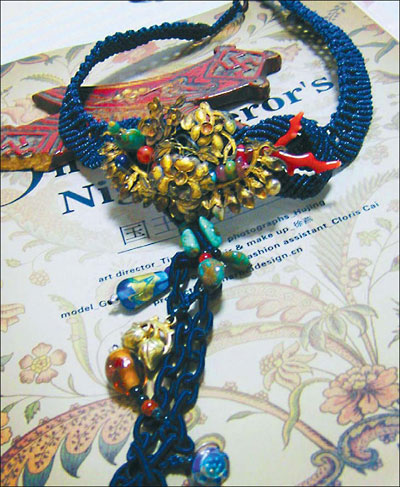Antique accessories for urban nomads
Updated: 2012-08-26 08:01
By Zhao Xu(China Daily)
|
|||||||

Forget about coveting antique jewelry in museum display cases. The modern-day fashionista can borrow some ancient style with the help of an elite group of jewelry designers. Zhao Xu looks at some of these most unusual talents.
Long before fancy feathers adorned the extravagant hats that decorated the Ascot Race days in England or the current rounds of aristocratic social events celebrating the Queen's Diamond Jubilee, the ladies of the Chinese court were already putting rare feathers on their well-coiffed heads.
Chinese craftsmen had long mastered the delicate art of mounting kingfisher feathers on gilt for hundreds of years, creating extremely extravagant headpieces to be set against the ebony heads of the elegant court ladies. This trend reached its peak in the late Qing Dynasty (1644-1911), but later abruptly faded into oblivion.
That is, until now. These days, women with a nostalgic bent can now enjoy a piece of that former glory, thanks to a little group of jewelry designers who have taken a step back in time for their inspiration.
Zhao Caixia's President Jewelry is housed in a bustling shopping mall in downtown Beijing. In spite of its name, the shop's decor is reminiscent more of a courtesan's decadent boudoir than a presidential suite.
Dim lighting creates the mood and strategically picks out the tempting glimmers that sparkle from the pieces of antique jade, agate and silver in the display cases.
According to the designer, her creations are not meant to encircle the slender necks of innocent waifs. Her chunky creations, the result of highly original and painstaking braiding and weaving, are for a bolder breed.
"My clients are 'urban nomads' - cultured, but still nomads," she says. "They understand the nuances of antiques, but are yet confident, even willful."
Some of the pieces have been infused with a sense of humor, which Zhao has projected through her encyclopedic knowledge of materials.
She combines unlikely choices such as a bronze warrior's breastplate with an aged patina that reflects its history, or a simple, well-used, slightly dented piece of flint. The "common thread" is bound by the art of braiding.
"Braiding is my first and ultimate choice," says Zhao, who started out as a dealer of antique embroidery pieces, and was first inspired by the finely crafted Chinese knots on her collection of vintage scented sachets.
"As an ancient handicraft, braiding can have a real dialogue with the antiques it tries to animate."
Today, Zhao employs a staff of 20 to craft the knots.
In comparison, Liu Xiting, another antique jewelry designer who was inspired by ancient braid work, prefers working alone.
Her efforts to create all her pieces alone seem almost heroic. "I prefer to do so because most of my decisions are impromptu during the process," she says, referring to intricate details of her work, ranging from constantly changing contours to graduating hues, and the carefully studied jumble of beaded gems.
The antique element in Liu's designs seems slightly off-kilter and does not become the focus. Instead, it seems to float upon a sea of riotous color. What results is Bohemian elegance marked by a studied disarray and asymmetrical beauty.
"I've dubbed my style 'neo-classicism' - elegant but not boring," says Lu. "It's haute boho for free spirits."
Not every designer goes for the "more is more" approach. Zhang Huiming, who makes antler-shaped lighting systems on the side, considers "understated simplicity" the essence of her antique jewelry creations.
"My designs are Chinese ink-on-paper, not Western realism," she says. "Everything comes from the heart instead of the eye."
Her design theory may sound abstract but in reality, it translates beautifully into pieces that combine and contrast the toned-down glaze of antique jade and silver with the muted tones of ebony wood. This mutual enhancement produces both serenity and sensuality, effects that Zhang intensifies with simple shapes and very little else.
"When I design, I don't consciously trouble myself with the question of whether I am following traditions or being modern," says the designer. "My works may not be visually very Chinese, but they are in fact the result of a persistent search for my own cultural identity."
According to Zhang, she chooses wood because the material is in itself a bearer and recorder of the effects of time.
"When exposed to air, wood oxidizes and darkens. It ages constantly, just like antiques," she explains.
And as for the traditional belief that a piece of jewelry should always shine, Zhang replies with a reference to the cobalt-blue feathers of the kingfisher, with a luster that remains undimmed by age and time.
Contact the writer at zhaoxu@chinadaily.com.cn.
|
(Top) Zhao Caixia's necklaces use ancient braids and beads, while the bracelet is Ma Jingji's Night Banquet. (Above) Lu Xiting's free-spirited craftsmanship adds that extra dimension to old treasures. Photos provided to China Daily |
(China Daily 08/26/2012 page14)
